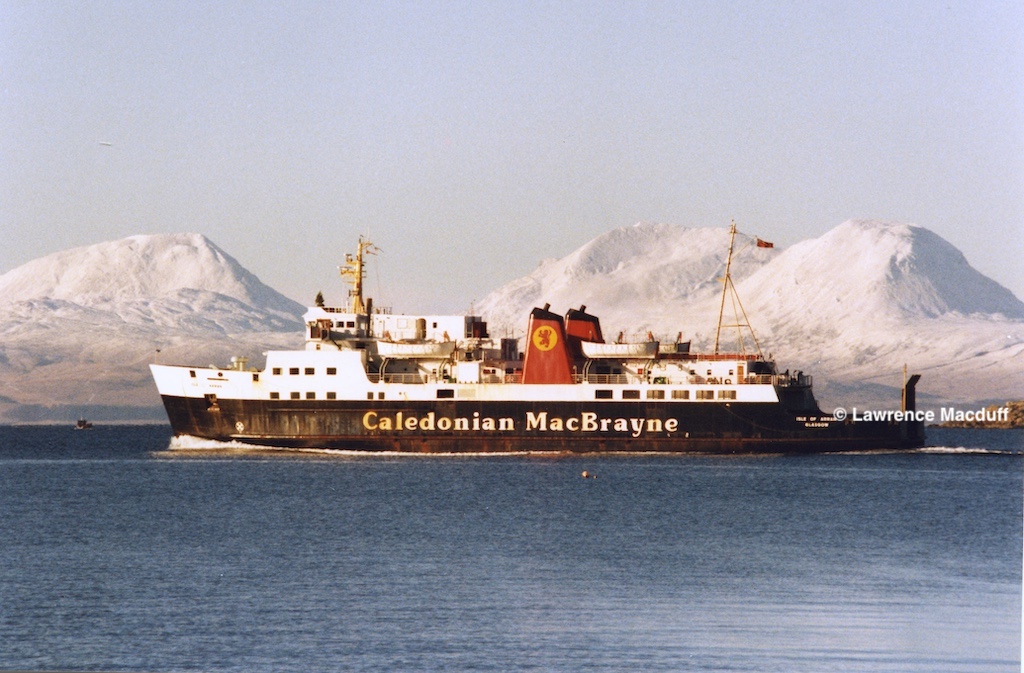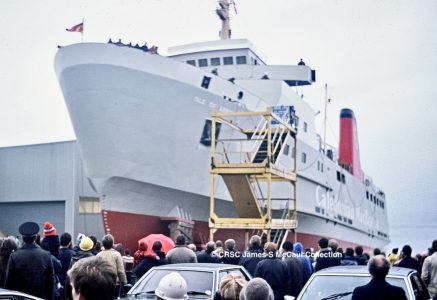
Ferry photography at its best: among the images shown by Lawrence Macduff in his CRSC presentation was his portrait of Isle of Arran emerging from West Loch Tarbert on 26 December 1995 against the backdrop of Jura’s snow-capped Paps
Few west coast ship enthusiasts are as well known as Lawrence Macduff. On 13 March he returned to a CRSC audience, at Glasgow’s Maldron Hotel, to delivery a fascinating talk about one of our favourite ferries. Report by Stuart Craig.
A ‘members only’ video of Lawrence’s presentation can be viewed here. It includes 80 images of Isle of Arran in various locations and guises.
Lawrence started his presentation with a rhetorical question: “Would any of us have believed in 1984 that Isle of Arran would still be a key player in the CalMac network 40 years later?”
The collective answer must be “no”, but what is more surprising is that she has spent recent winters serving Barra and is currently the sole vessel on the route for which she was designed: Ardrossan-Brodick!
“She is a ‘favourite’,” Lawrence continued, “on a par with Glen Sannox (1957) and Pioneer (1974).”
Many of us would agree.

O happy day: launch of Isle of Arran at Port Glasgow, 2 December 1983. She looked good in a French grey livery, but the hull was painted black before she entered service in April 1984
Isle of Arran was built by Ferguson-Ailsa Ltd of Troon and Port Glasgow and launched in December 1983. She was in service just four months later on the Arran route, taking on the mantle of her predecessors Glen Sannox, Caledonia and Clansman (1964).
On the arrival of Caledonian Isles in 1993 she was sent to the Islay route, and since then has called at almost every west coast linkspan, from Campbeltown to Stornoway. In fact, she wasn’t long in service before she showed her usefulness as a relief vessel, being sent to Ullapool to relieve Suilven in October 1984.
Lawrence embarked on a detailed description in his inimitable, relaxed style, explaining how Isle of Arran’s appearance has changed over the years. Indeed, no CalMac ship has evolved as much as Isle of Arran, partly because of the need to adapt to new regulations and partly because of the different demands of the various routes on which she has been employed. One of her lounges, for example, was converted to crew accommodation when the ship was no longer serving the ‘local’ route of Ardrossan to Brodick.
Her livery changed, too. Having been launched with a French grey hull (repainted black up to gallery deck level before her entry into service), she underwent two subsequent changes of livery: just a year into service, the white of her superstructure was lowered to main deck level, only to be zig-zag’d (like Hebridean Isles) in 1998.
Lawrence’s stories and photographs brought back memories for everyone in the audience, as we all know this ship so well. He also gave us some interesting factoids. Here is one: she is the only diesel ferry to have reached 40 years with her original engines. And another: when built she was able to accommodate more seated passengers than any of her predecessors.

Best suited livery? Isle of Arran at Ardrossan on 8 June 1985, the year in which the white of her superstructure was taken down to below gallery deck level
Lawrence picked out idiosyncracies which many of us have taken for granted over the years but which rang true when pointed out. One is the long bench-seating in the cafeteria, where you can feel trapped between the fish ’n chips and steak pie. Another — the rows of red, concave seating on her upper deck which, apart from inducing lumbago, are nearly impossible to extract oneself from. And what about the hot-air vents at the base of the inner sides of the funnels? This, said Lawrence, was an ideal place to stand when out on deck on a cold day. I must remember that one.
Lawrence is known to be one of the best ship photographers around. My favourite image of the evening (and it was difficult to choose) was a wintry scene of our ship sailing down West Loch Tarbert with the snow-covered Paps of Jura in the background – simply stunning. He let slip one of his best-kept secrets, telling us that his favourite vantage point is Dunskeig Hill at the entrance to that same loch. Does he not realise that his fellow steamer enthusiasts have been referring to the hill as ‘Macduff Mound’ for years?
He described an eventful journey there during the white-out of December 2010, when he drove 90 miles to photograph Isle of Arran against the snowy background. Despite being stopped by the police at Ardrishaig (but allowed to continue), he must have enjoyed the experience very much, as he repeated the journey the following day.
The presentation ended with a grand tour of the west coast, showing the ship at every pier she has graced, including Tobermory, Campbeltown and her single call at Dunoon in 2005.
Lawrence is an easy man to listen to. His style of delivery always sounds spontaneous but is in fact based on long experience and detailed preparation. His tribute to Isle of Arran followed that distinctive mould, and was thoroughly appreciated by his audience.

Lawrence Macduff at Kennacraig on 23 April 2023, when he was the coach driver for CRSC’s excursion to Islay on MV Isle of Arran

After his Isle of Arran presentation to CRSC on 13 March, Lawrence Macduff (right) was congratulated by Captain Calum Bryce, master of MV Bute
Lawrence Macduff has been a member of CRSC for as long as he can remember. Have you joined this friendly association of ship enthusiasts? Click here for your £15 introductory membership and you’ll get all the benefits, including CRSC’s highly prized colour magazine, the annual Review of west coast shipping and exclusive access to photo-rich ‘members only’ posts on this website.
Published on 14 March 2024











